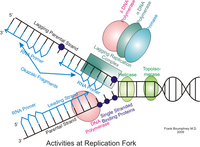
Photo from wikipedia
Simple Summary Triple-negative breast cancer (TNBC) is a subtype of invasive breast cancer with an aggressive phenotype that has decreased survival compared with other types of breast cancers, due in… Click to show full abstract
Simple Summary Triple-negative breast cancer (TNBC) is a subtype of invasive breast cancer with an aggressive phenotype that has decreased survival compared with other types of breast cancers, due in part to the lack of biomarker driven targeted therapies. Here, we show that breast cancer patients whose tumors show high levels of cyclin E expression have a higher prevalence of BRCA1/2 alterations and have the worst clinical outcomes. In vitro and in vivo studies revealed that combination therapies with poly (ADP-ribose) polymerase (PARP) and Wee1 kinase inhibitors in TNBC cells with either BRCA1 mutations or high levels of cyclin E results in synergistic cell death due to induction of replicative stress and downregulation of DNA repair. These studies suggest that by preselecting patients whose tumors have high cyclin E levels or harbor mutations in BRCA1, only those cases with the highest replicative stress properties will be subjected to combination treatment and likely result in synergistic activity of the two agents. Abstract The identification of biomarker-driven targeted therapies for patients with triple negative breast cancer (TNBC) remains a major clinical challenge, due to a lack of specific targets. Here, we show that cyclin E, a major regulator of G1 to S transition, is deregulated in TNBC and is associated with mutations in DNA repair genes (e.g., BRCA1/2). Breast cancers with high levels of cyclin E not only have a higher prevalence of BRCA1/2 mutations, but also are associated with the worst outcomes. Using several in vitro and in vivo model systems, we show that TNBCs that harbor either mutations in BRCA1/2 or overexpression of cyclin E are very sensitive to the growth inhibitory effects of AZD-1775 (Wee 1 kinase inhibitor) when used in combination with MK-4837 (PARP inhibitor). Combination treatment of TNBC cell lines with these two agents results in synergistic cell killing due to induction of replicative stress, downregulation of DNA repair and cytokinesis failure that results in increased apoptosis. These findings highlight the potential clinical application of using cyclin E and BRCA mutations as biomarkers to select only those patients with the highest replicative stress properties that may benefit from combination treatment with Wee 1 kinase and PARP inhibitors.
Journal Title: Cancers
Year Published: 2021
Link to full text (if available)
Share on Social Media: Sign Up to like & get
recommendations!